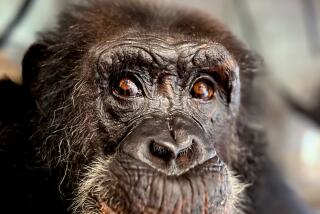They’re just like family, only hairier
- Share via
Mahale, Tanzania — AT age 16, Orion is a handsome chimpanzee, a primate hottie. Despite his status as a creature of the wild, his glossy black coat looks as if it were combed and fluffed by a personal groomer. It gleams in morning sunlight filtering through towering forest trees.
Orion remains oblivious to the spell he casts over his observers -- also primates, but this species clad in dusty hiking boots, safari wear and a thin coat of sweat. He doesn’t notice when one of them, clutching a camera, breaks from the group and scrambles halfway up a tree to get a better shot.
Orion cares only about the ants.
Cocktail ants, to be precise. The creatures are nicknamed cocktail ants because the distinctively large end of the abdomen can be cocked over the thorax for protection.
With his right hand, Orion pushes a slender twig into the insects’ nest buried in the bark; he clutches a set of spare twigs in his toes. Ants cling to this natural utensil as he pulls it from the nest -- only to be polished off by the chimpanzee, who punctuates his enjoyment with much lip smacking and the occasional passing of wind.
By the end of our three days at Mahale Mountains National Park in Tanzania, Orion feels like one of the family. So do the other chimpanzees that make up the 65-odd habituated animals that researchers from Kyoto University in Japan have studied for about 30 years.
My husband, Alan Feldstein, and I expected to see chimps in this remote area on the western border of Tanzania, East Africa. But we never dreamed we’d come to know them by name.
There is Gwekulo, the “spinster”; her limping gait suggests she may have broken a leg or pelvis and either become barren or been rejected by the males. Now she serves as nanny to the babies of other females. There is Opal, who has a bald spot on her forehead.
There is strong Alofu, the reigning alpha male, and wise Kalunde, “the King Maker,” at 53 the oldest of the group and a former alpha. (A chimp’s average life span is 50 to 60 years.) Kalunde did not suffer the rejection typical of most deposed alpha males. That’s because he teamed up with Alofu’s mother in negotiating Alofu into power.
Christina, another female, shamelessly flirts with Alan, showing off her squishy mouthful of figs.
These habituated chimps -- the “M” group -- are a subset of the chimpanzees, numbering about 700, that live in the Mahale Mountains above Lake Tanganyika, the second-largest lake in Africa. Across the lake lies Gombe National Park, another chimpanzee preserve and home of the Jane Goodall Institute for Wildlife Research, Education and Conservation.
The people who come to Mahale, say the managers of our posh but tantalizingly wild lake-shore camp, represent a subset of the many tourists who visit Tanzania on safari every year. They are travelers for whom checking off the requisite “big five” -- elephant, rhinoceros, lion, leopard and Cape buffalo -- from the inside of a Land Rover is no longer quite enough.
Australian Teena Payne and Englishman Steve Chumbley, who manage Greystoke Mahale Camp -- run by Nomad Tanzania Safari Camps -- call the standard Tanzanian safari “the milk run” because it tends to include the same stops: Arusha National Park, Tarangire, the Serengeti and Ngorongoro Crater.
Five years before, we had done just that, through Thomson Safaris, based in the Boston area. That’s how we fell in love with Africa. All it took was the first sight of a female giraffe in Arusha, bending her graceful neck to munch leaves from an acacia tree right outside our vehicle -- well, she had us at jambo (Swahili for “hello”).
But this time we were, indeed, ready for something new. On this trip, as a 50th birthday celebration, Alan wanted to climb Mt. Kilimanjaro. (He made it.) Not yet having reached that birthday milestone, I decided not to, but if I was going to join him after the climb, I wanted to venture off-road, so to speak. Thomson Safaris suggested Mahale.
Most travelers, including us, can’t afford to travel to Africa just to visit Mahale, so they add it on as an optional extension to a more conventional safari. Between the Kili climb and Mahale, we spent five days on safari, revisiting Ngorongoro and the Serengeti.
At one Serengeti camp, we took a hike through the bush, led by a local Ikoma tribesman. He carried a poison-tipped spear, which, he explained, could take down an elephant, lion or Cape buffalo in 30 minutes. We don’t know much Swahili, but a hushed conversation between the tribesman and our safari guide included the word simba -- making us think that 30 minutes is a very, very long time.
But if that hike was a walk on the wild side, Mahale was a walk on another planet -- the planet of the chimps.
The sense of entering another world began upon landing on the primitive Mahale airstrip. Before reaching Mahale, our nine-seater Cessna landed at Katavi airstrip to drop off some passengers visiting Katavi National Park. As soon the plane landed, staffers from Mahale were grabbing our duffel bags and ordering us to remove our hiking boots to wade through the water to the dhow-style boat that would take us to Greystoke Mahale Camp, one of several such facilities in Mahale.
After five days in the bush, I found it strange to be surrounded by water and bright white sand, stranger still to see l a thatched-roof, open-air construct with what appeared to be two big ears extending out to each side. Payne jokingly called it “the cocker spaniel.”
The six individual lodgings are equally exotic. They call them the bandas -- two-story, triangular structures fashioned of timber from old dhows. Because they are open-air, your morning alarm is the screeching of the crowned hornbill. And it’s a treat to pull back the mosquito netting around the king-size bed to watch chattering colobus monkeys swinging through lacy fig trees just outside.
It was Payne, barefoot and smiling, who greeted our boat. She led us to the “cocker spaniel.” The middle part is the dining hall -- the walls of which are decorated with oddly glamorous black-and-white head shots of chimpanzees. It was a gallery of the alpha males of “M” group, circling the room like the portraits of the popes at the Vatican.
PAYNE explained the rules of “chimping.” At 7 each morning, two trackers head up into the mountains to seek signs of chimp activity as they descend from the treetop nests they build each night. Trackers can predict the chimps’ whereabouts by noise from the trees or signs that they have been feeding on leaves or fruit. When they find the animals, the trackers radio back to camp, and a guide leads a group of not more than six at a time into the mountains.
There are strict park rules: A group may observe the chimps only for an hour at a time; the idea is to see them in their natural habitat without altering it. No touching, feeding or flash photography.
Chimpanzees stand 4 to 5 feet and weigh 100 to 120 pounds; their strength is about five times that of humans. But none of the four who had just arrived -- us and a friendly British couple -- seemed worried about chimp contact. We may have been slightly more apprehensive about the other area critters Payne breezily described: bush pigs, wart hogs, snakes, hippos and crocodiles, and a rarely seen leopard.
The next morning at breakfast, Chumbley gave us the disappointing tracker’s report: no sign of the chimps. Still we could start hiking and hope to meet up with them. We decided to head for the forest. We met our guide -- Seif Mohamedi, a Tongwe tribesman -- and waded out to the boat that would take us to the site of our trek.
We hiked and hiked. The temperature was in the 80s, but it seemed hotter with the humidity. We scrambled up steep inclines, over boulders and into deep ravines, with Mohamedi ahead of us slashing the jungle vines with his machete and our other guide, the silent, bespectacled Yassini Kiyoya, bringing up the rear -- sometimes quite literally, giving an encouraging upward shove to the posterior of a hiker.
Two-and-a-half hours and several energy bars later -- no chimpanzees.
We returned to camp, slipped into our kikois, colorful sarongs that are the standard Mahale beachwear/dinner-wear/ any-wear, had lunch and prepared for a nice afternoon of relaxing, maybe a swim. We were disappointed but hardly unhappy; we would see the chimps tomorrow. But around 3 p.m., Chumbley told us that the trackers had radioed back to say they had found the chimps.
*
A sighting
WE ran back to our bandas, threw on our hiking clothes, got back on the boat. Once we landed, we struggled to keep up with our guides, who seemed to be racing the clock. But time seemed to stop when we spied several chimpanzees calmly loping down the path in front us. The noise of our hiking boots crunching on dry leaves seemed deafening; we tried to follow as quietly as possible as the chimpanzees led us toward a rocky stream bed -- and a group of about 10 chimpanzees, playing, grooming and resting, oblivious to our awed presence.
The group included several babies; we were told the researchers didn’t name them until they were 2 years old because so many die young. Along with chimps, we also found Kyoto University researchers with huge camera lenses and grim expressions, seeming generally annoyed by our presence.
From that sighting on, we were happy chimpers. The next morning, we encountered a group of mothers and babies -- along with “Aunt” Gwekulo, engaged in a blissful session with a baby chimpanzee that grinned as Gwekulo cuddled him.
By the third day, we had become more sure-footed and greedier; we wanted to encounter the male chimps that dominate “M” group and tend to congregate higher in the mountains. That day, our first meeting was with Orion and his ants, but then our guides led us upward, through denser jungle, in the direction of the sudden, shrieking cries that ripped through the treetops.
The next hour led us to senior Kalunde, quietly holding court in the shade of a tree; Masudi, who ranks No. 5; the second-ranking chimp, Bonobo; and, finally, Alofu, a hulking figure.
The next morning, we prepared to leave camp for the long trip home -- but not before we heard the report from some newly arrived chimpers that they had seen a group of chimpanzees tear apart and eat a colobus monkey that morning. Contrary to popular belief, chimps are not exclusively vegetarian. Because the chimps are now our family, we were glad to have missed the kill.
*
(BEGIN TEXT OF INFOBOX)
Getting in the swing
GETTING THERE:
From LAX to Dar es Salaam in Tanzania, connecting service (change of plane) is available on American, British, KLM, Northwest United and Virgin Atlantic; restricted round-trip fares begin at $2,200. Tour companies may offer special airfares to Tanzania.
TOUR COMPANIES:
Companies offering Mahale extensions include:
Thomson Safaris, (800) 235-0289, www.thomsonsafaris.com, Thomson, based in the Boston area, is the company we went with.
Africa Dream Safaris, in the Los Angeles area, (877) 572-3274, www.africadreamsafaris.com.
AfricanMecca (866) 527-4281, www.africanmeccasafaris.com, has U.S. operations in Allentown, Pa.
Wild and Exotic Ltd., 011-44-14-3974-8401, www.wildandexotic.co.uk, is a high-end company in England.
Costs vary depending on accommodations. Thomson offers a three-night extension (from $2,990 per person) and a four-night (from $3,490 per person) at luxury Mahale Greystoke Camp. That includes meals, transfers, chimp permits, park fees, guides and internal flights.
WHERE TO STAY:
Tour companies make arrangements with three private Mahale camps, Greystoke Mahale Camp, Flycatcher Safari Camp and Nkungwe Luxury Tented Camp. In general you cannot make arrangements directly.
Kigoma Hilltop Hotel in the nearby town of Kigoma also offers chimpanzee trekking ; 011-28-280-4435-67, www.kigoma.com.
TO LEARN MORE:
Embassy of the United Republic of Tanzania, (202) 939-6125, www.tanzaniaembassy-us.org.
Also see www.tanzaniatouristboard.com and www.tanzaniaparks.com.
-- Diane Haithman
More to Read
Sign up for The Wild
We’ll help you find the best places to hike, bike and run, as well as the perfect silent spots for meditation and yoga.
You may occasionally receive promotional content from the Los Angeles Times.






